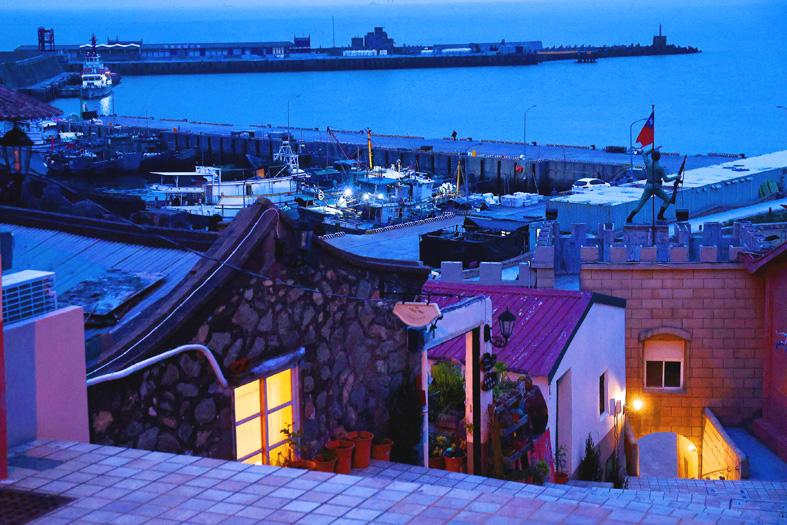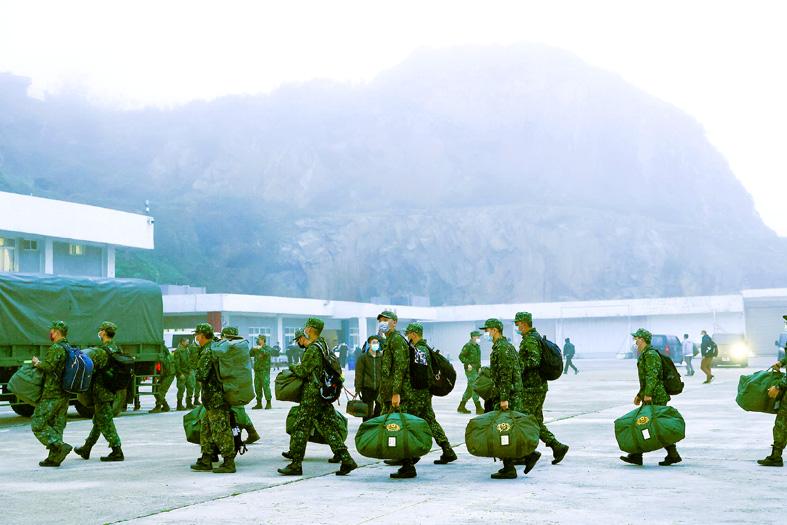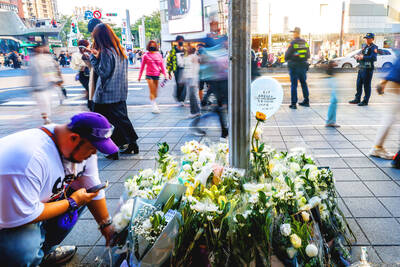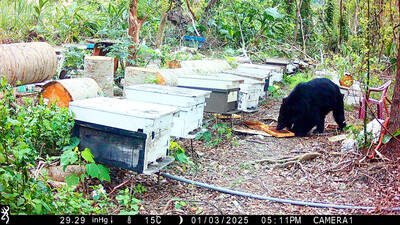Lin Jih-shou was brewing tea last month in his popular breakfast joint when he heard the buzz of a plane — a rare sound on Dongyin Island (東引), which does not have an airport.
Lin, 64, rushed outside, but only saw the shadow of what the government later described as a small, propeller-driven Chinese aircraft that most likely was testing Taiwan’s military response.
It was a stark reminder to residents of Dongyin and other islands off China’s coast of the threat from their huge neighbor.

Photo: Ann Wang, Reuters
The Matsu Islands were regularly bombarded by China at the height of the Cold War, and the history of conflict has focused minds on Russia’s invasion of Ukraine and whether the same fate might befall them.
“When we watch Russia and Ukraine fighting, our hearts hurt,” Lin said. “War is too scary. There’s no need.”
Held by Taiwan since the Chinese Nationalist Party (KMT) regime fled China in 1949 after losing the Chinese Civil War, Matsu would probably be an immediate target for Beijing in a conflict, especially Dongyin’s missile base.

Photo: Ann Wang, Reuters
Yet even with China’s increased military pressure over the past few years, the archipelago has seen trendy businesses and a nascent art scene spring up.
On the main island of Nangan (南竿), former military brothels and underground bunkers house exhibitions that opened last month as part of the inaugural Matsu Biennial art festival.
Outlying islands are being reframed as “a front line of democracy,” said Lii Wen, who established the local branch of the Democratic Progressive Party in 2020.
Dongyin native Tsai Pei-yuan, born in 1993, the year after Matsu’s strict military rule ended, is part of a generation for whom war feels distant.
Two years ago, Tsai and two former classmates cofounded Salty Island Studio, a cafe and community hub that hosts arts workshops and plays.
“More urgent is trying to preserve our culture, which is disappearing,” Tsai said before a wine-tasting event last week.
The Ukraine war is a common topic of conversation for some — including jokes about where to hide if China invades.
“When we explore strongholds, we ask, if a war really starts, which nearby stronghold would we run to?” said Chung Jing-yei, 26, who manages a restaurant.
Chung said it was only after she moved to Nangan that she understood why so many here want to maintain the “status quo.”
“My belief that we should be an independent country is resolute, but at the same time, I don’t want war to happen,” she said.
Dotting the islands’ rugged coastlines are bunkers, abandoned or transformed into tourist destinations and boutique hotels.
Older Matsu residents have vivid memories of hiding in shelters from Chinese shelling and not being allowed to own basketballs for fear that they might use them to float across to China.
“I don’t think the two sides will fight,” said Lucy Lin, a 62-year-old taxi driver and bakery owner. “As long as you don’t step over the red lines.”

SHIPS, TRAINS AND AUTOMOBILES: The ministry has announced changes to varied transportation industries taking effect soon, with a number of effects for passengers Beginning next month, the post office is canceling signature upon delivery and written inquiry services for international registered small packets in accordance with the new policy of the Universal Postal Union, the Ministry of Transportation and Communications said yesterday. The new policy does not apply to packets that are to be delivered to China, the ministry said. Senders of international registered small packets would receive a NT$10 rebate on postage if the packets are sent from Jan. 1 to March 31, it added. The ministry said that three other policies are also scheduled to take effect next month. International cruise ship operators

HORROR STORIES: One victim recounted not realizing they had been stabbed and seeing people bleeding, while another recalled breaking down in tears after fleeing A man on Friday died after he tried to fight the knife-wielding suspect who went on a stabbing spree near two of Taipei’s busiest metro stations, Taipei Mayor Chiang Wan-an (蔣萬安) said. The 57-year-old man, identified by his family name, Yu (余), encountered the suspect at Exit M7 of Taipei Main Station and immediately tried to stop him, but was fatally wounded and later died, Chiang said, calling the incident “heartbreaking.” Yu’s family would receive at least NT$5 million (US$158,584) in compensation through the Taipei Rapid Transit Corp’s (TRTC) insurance coverage, he said after convening an emergency security response meeting yesterday morning. National

The Forestry and Nature Conservation Agency yesterday launched a gift box to market honey “certified by a Formosan black bear” in appreciation of a beekeeper’s amicable interaction with a honey-thieving bear. Beekeeper Chih Ming-chen (池明鎮) in January inspected his bee farm in Hualien County’s Jhuosi Township (卓溪) and found that more than 20 beehives had been destroyed and many hives were eaten, with bear droppings and paw prints near the destroyed hives, the agency said. Chih returned to the farm to move the remaining beehives away that evening when he encountered a Formosan black bear only 20m away, the agency said. The bear

PLANNED: The suspect visited the crime scene before the killings, seeking information on how to access the roof, and had extensively researched a 2014 stabbing incident The suspect in a stabbing attack that killed three people and injured 11 in Taipei on Friday had planned the assault and set fires at other locations earlier in the day, law enforcement officials said yesterday. National Police Agency (NPA) Director-General Chang Jung-hsin (張榮興) said the suspect, a 27-year-old man named Chang Wen (張文), began the attacks at 3:40pm, first setting off smoke bombs on a road, damaging cars and motorbikes. Earlier, Chang Wen set fire to a rental room where he was staying on Gongyuan Road in Zhongzheng District (中正), Chang Jung-hsin said. The suspect later threw smoke grenades near two exits